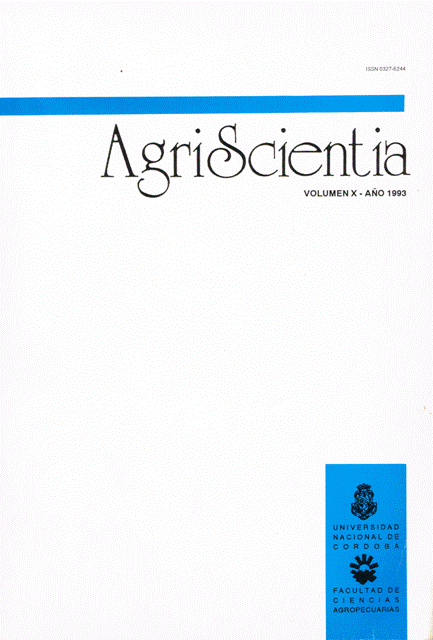Biological aspects of Acrosternum apicicorne (Spinola, 1862) (Hemiptera, Pentatomidae)
Main Article Content
Abstract
In this paper, biological aspects of Acrosternum apicicorne were studied under laboratory conditions (temperature = 23.5 ± 0.8°C; relative humidity = 68.4 ± 6.5%; photoperiod = 16 h). Insects were fed with fresh fruits of Phaseolus vulgaris (L.). Under such conditions, the following results were obtained: life cycle length = 45.3 ± 4.7 days; nymphal mortality = 49 ± 23.3%; adult longevity = 97.3 ± 1.3 days; number of eggs per female = 115.6 ± 67.6.
Under laboratory conditions, compared to other pentatomids such as Nezara viridula (L.) and Piezodorus guildinii (West.), A. apicicorne showed a reproductive ability lower than Nezara and higher than Piezodorus. Laboratory observations were complemented with field observations. The latter showed that A. apicicorne populations are not only sporadic but also low.
Article Details

This work is licensed under a Creative Commons Attribution-ShareAlike 4.0 International License.
How to Cite
References
Fraga, C. P., & Ochoa, L. H. (1972). Aspectos morfológicos y bioecológicos de Piezodorus guildinii (West.) (Hemiptera, Pentatomidae). I.D.I.A. Suplemento, 28, 103-117.
Grazia, J., Del Vecchio, M. C., & Hildebrand, R. (1982). Estudo das ninfas de pentatomídeos (Heteroptera) que vivem sobre soja (Glycine max (L.) Merril). IV-Acrosternum impicticorne (Stål, 1872). Anales da Sociedade Entomológica do Brasil, 11, 261-268.
Hallman, G. J., Morales, C. G., & Duque, M. C. (1992). Biology of Acrosternum marginatum (Heteroptera: Pentatomidae) on common beans. Florida Entomologist, 75(2), 190-196.
Harris, V. E., & Todd, J. W. (1981). Rearing the southern green stink bug, Nezara viridula, with relevant aspects of its biology. Journal of the Georgia Entomological Society, 16(2), 203-211.
Hayward, K. (1942). Primera lista de insectos tucumanos perjudiciales. Estación Experimental Agrícola Tucumán, Publicación Miscelánea, N.º 1, 110 pp.
La Porta, N. C., & de Crouzel, I. S. (1984). Estudios básicos para el control biológico de Nezara viridula (L., 1758) (Hemiptera, Pentatomidae) en la Argentina. Revista de la Sociedad Entomológica Argentina, 43(1-4), 119-143.
Panizzi, A. R., & Smith, J. G. (1977). Biology of Piezodorus guildinii: Oviposition, development time, adult sex ratio and longevity. Annals of the Entomological Society of America, 70, 35-39.
Panizzi, A. R., & Slansky, F., Jr. (1985). Review of phytophagous pentatomids (Hemiptera: Pentatomidae) associated with soybean in the Americas. Florida Entomologist, 68(1), 184-214.
Pirón, A. A. (1948). Contribución al conocimiento de la dispersión geográfica de los hemípteros neotropicales. Acta Zoologica Lilloana, 5, 5-17.
Rabinovich, J. (1980). Introducción a la ecología de las poblaciones animales. C.E.C.S.A.
Rizzo, H. (1972). Insectos y otros animales enemigos de la soja (Glycine max (L.) Merril) en la Argentina. Filotecnia Latinoamericana, 8, 44-49.
Rolston, H. L. (1983). A revision of the genus Acrosternum Fieber, subgenus Chinavia Orian, in the Western Hemisphere (Hemiptera, Pentatomidae). Journal of the New York Entomological Society, 91(2), 97-176.
Sailer, R. I. (1952). A technique for rearing certain hemiptera. U.S. Department of Agriculture, Bureau of Entomology and Plant Quarantine, ET-303, 5 pp.
Saini, E. (1984). Identificación de los huevos de pentatómidos (Heteroptera) encontrados en cultivos de soja. I.D.I.A., N.º 9, 425-428.
Saini, E. (1989). Clave para la identificación de las ninfas de pentatómidos encontrados en cultivos de soja. Revista de la Sociedad Entomológica Argentina, 46(1-4), 129-139.
Vicentini, R., & Jiménez, H. A. (1977). El vaneado de los frutos en soja. INTA, Serie Técnica, N.º 47, 1-30.





